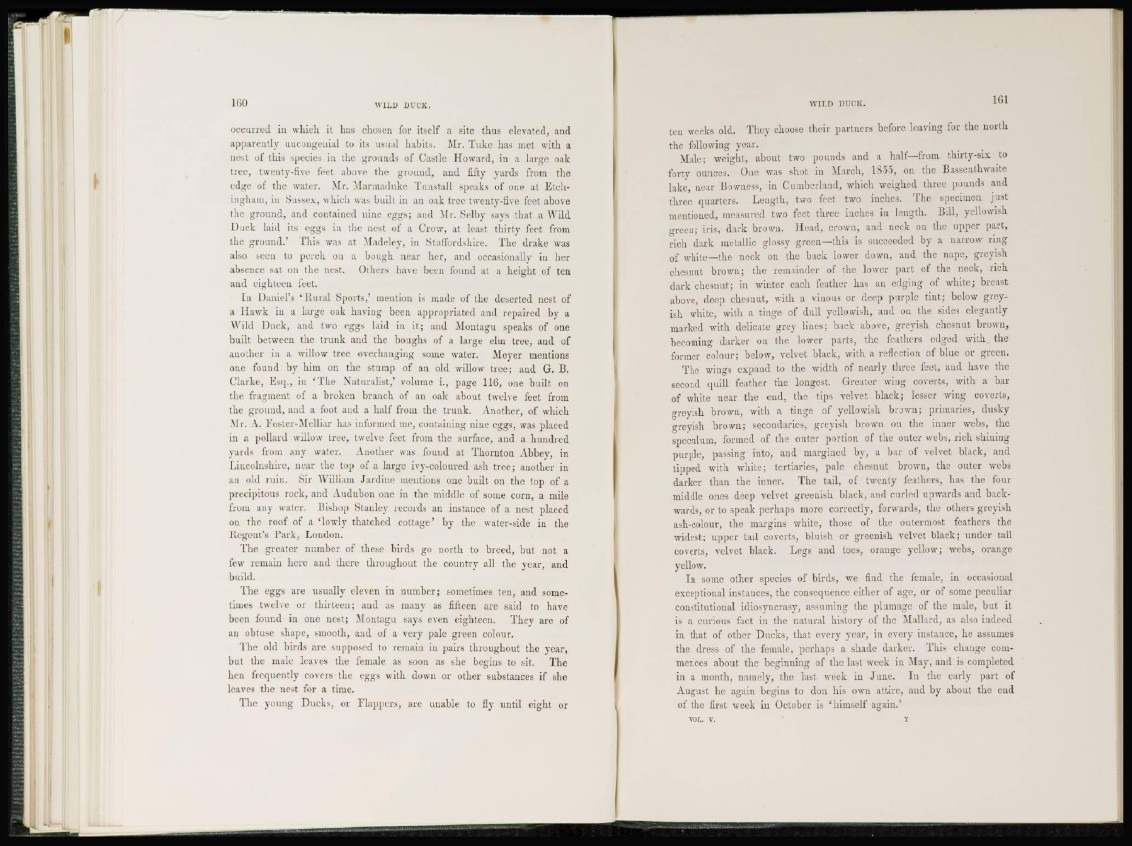
occurred in which it lias chosen for itself a site thus elevated, and
apparently uncongenial to its usual habits. Mr. Tuke has met with a
nest of this species in the grounds of Castle Howard, in a large oak
tree, twenty-five feet above the ground, and fifty yards from the
edge of the water. Mr. Marniaduke Tunstall speaks of one at Etchinghain,
in S u s s e x , which was built in an oak tree twenty-five feet above
the ground, and contained nine eggs; and Mr. Selby says that a Wild
Duck laid its e g g s in the nest of a Crow, at least thirty feet from
the ground.' This was at Madeley, in Staffordshire. The drake was
also seen to perch on a bough near her, and occasionally in her
absence sat on the nest. Others have been found at a height of ten
and eighteen feet.
In Daniel's ' Rural Sports,' mention is made of the deserted nest of
a Hawk in a large oak having been appropriated and repaired by a
Willi Duck, and 1 wo eggs laid in it; and Montagu speaks of one
built between the trunk and the boughs of a large elm tree, and of
another in a willow tree overhanging some water. Meyer mentions
one found by him on the stump of an old willow tree; and G. B.
Clarke, Esq., in ' T h e Naturalist,' volume i., page lib", one built on
the fragment of a broken branch of an oak about twelve feet from
the ground, and a foot and a half from the trunk. Another, of which
Mr. A. Foster-Mel liar has informed me, containing nine eggs, was placed
in a pollard willow tree, twelve feet from the surface, and a hundred
yards from any water. Another was found at Thornton Abbey, in
Lincolnshire, near the top of a large ivy-coloured ash tree; another in
an old ruin. Sir William Jardine mentions one built on the toj) of a
precipitous rock, and Audubon one in the middle of some corn, a mile
from any water. Bishop Stanley records an instance of a nest placed
on the roof of a 'lowly thatched cottage' by the water-side in the
Regent's Park, London.
The greater number of these birds go north to breed, but not a
few remain here and there throughout the country all the year, and
build.
The eggs are usually eleven in number; sometimes ten, and sometimes
twelve or thirteen; and as many as fifteen are said to have
been found in one nest; Montagu says even eighteen. They are of
an obtu>e shape, smooth, and of a very pale green colour.
The old birds arc; supposed to remain in pairs throughout the year,
but the male leaves the female as soon as she begins to sit. The
hen frequently covers the eggs with down or other substances if she
leaves the nest for a time.
The young Ducks, or Flappers, are uuablc to fly until eight or
ten weeks old. They choose their partners before leaving for the north
the following year.
Male; weight, about two pounds and a half—from thirty-six to
forty ounces. One was shot in March, 1855, on the Bassenthwaite
lake, near Bowness, in Cumberland, which weighed three pounds and
three quarters. Length, two feet two inches. The specimen just
mentioned, measured two feet three inches in length. Bill, yellowish
green; iris, dark brown. Head, crown, and neck on the upper part,
rich dark metallic glossy green—this is succeeded by a narrow ring
of wdiitc—the neck on the back lower down, and the nape, greyish
chesnut brown; the remainder of the lower part of the neck, rich
dark chesnut; in winter each feather has an edging of white; breast
above, deep chesnut, with a vinous or deep purple tint; below greyish
white, with a tinge of dull yellowish, and on the sides elegantly
marked with delicate grey lines; back above, greyish chesnut brown,
becoming darker on the lower parts, the feathers edged with the
former colour; below, velvet black, with a reflection of blue or green.
The wings expand to the width of nearly three feet, and have the
second quill feather the longest. Greater wing coverts, with a bar
of white near the cud, the tips velvet black; lesser wing coverts,
greyish brown, with a tinge of yellowish brown; primaries, dusky
greyish brown; secondaries, greyish brown on the inner webs, the
speculum, formed of the outer portion of the outer webs, rich shining
purple, passing into, and margined by, a bar of velvet black, and
tipped with white; tertiaries, pale chesnut brown, the outer webs
darker than the inner. The tail, of twenty feathers, has the four
middle ones deep velvet greenish black, and curled upwards and backwards,
or to speak perhaps more correctly, forwards, the others greyish
ash-colour, the margins white, those of the outermost feathers the
widest; upper tail coverts, bluish or greenish velvet black; under tail
coverts, velvet black. Legs and toes, orange yellow; webs, orange
yellow.
I n some other species of birds, we find the female, in occasional
exceptional instances, the consequence either of age, or of some peculiar
constitutional idiosyncrasy, assuming the plumage of the male, but it
is a curious fact in the natural history of the Mallard, as also indeed
in that of other Ducks, that every year, in every instance, he assumes
the dress of the female, perhaps a shade darker. This change commences
about the beginning of the last week in May, and is completed
in a month, namely, the last week in June. In the early part of
August he again begins to don his own attire, and by about the end
of the first week in October is 'himself again.'
VOL. v. y